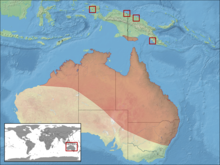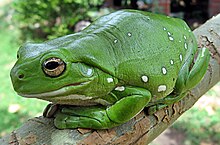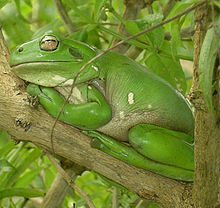Coral finger tree frog
| Coral finger tree frog | ||||||||||||
|---|---|---|---|---|---|---|---|---|---|---|---|---|

Coral finger tree frog ( Ranoidea caerulea ) |
||||||||||||
| Systematics | ||||||||||||
|
||||||||||||
| Scientific name | ||||||||||||
| Ranoidea caerulea | ||||||||||||
| ( White , 1790) |
The coral finger tree frog ( Ranoidea caerulea , synonym : Litoria caerulea ), often just called coral finger , is a frog from the family of the Australian tree frogs (Pelodryadidae) native to Australia and New Guinea . The English surgeon John White first described this species scientifically in 1790. For a climbing tree frog , the coral finger is comparatively large and massive. The animals are considered relatively tame and often live near human settlements. Due to their apparently smiling appearance and sedate nature, coral finger tree frogs are particularly popular with humans. The antibacterial and antiviral properties of their skin secretions also make them interesting for pharmacology .
Taxonomy
John White was the first to describe the species in his book Journal of a Voyage to New South Wales . However, since the preparation that he sent to England changed its color on the way, the coral finger tree frog was classified as Rana caerulea (from the Latin words for "frog" and "blue"). The actual green color of the frog is based on blue pigments that are on a yellow layer. The latter, however, evaporated when the sample was prepared, so that the preserved animal appeared blue. (However, there may actually be living blue specimens that also lack the yellow dye!)
Later, the species was long led under the scientific name Hyla caerulea within the subfamily Hylinae , so among other things in the same genus as the European tree frog ( Hyla arborea ). Ultimately, however, a separation of the Australian tree frogs from the genus Hyla (actual tree frogs) has established itself in the zoological system , which is mainly based on biogeographical , less morphological reasons. The genera Ranoidea as well as Litoria and Nyctimystes are now classified in a separate family Australian tree frogs (Pelodryadidae).
The species got its German trivial name because of its hands, which are sometimes pale pink ("coral-colored"); however, this color description often does not apply.
distribution

The original range of the coral finger is the north and east of Australia (especially Queensland and Northern Territory ) and New Guinea (especially its south in locations below 200 m above sea level). Its habitat includes areas with a warm, humid, subtropical to tropical climate. In the warm-temperate southeast of Australia, it occurs only where there is no “wintry” cold season, for example in the lowlands of the state of New South Wales . Humans also spread the species as a neozoon in parts of New Zealand and the United States . Smaller, reproductive populations can be found in two regions of Florida . The animals that once existed in New Zealand have not been sighted since the 1950s .
features
Coral fingers are large, clumsy tree frogs that can grow to be four to twelve inches long (the females grow slightly larger than the males). The very broad head has a short, round snout and the slightly upwardly drawn corners of the mouth give the animals an apparently smiling facial expression. Behind the eyes, which have a silver or gold metallic-colored iris with a horizontal pupil , a bulging, gland-rich skin thickening runs above the clearly visible eardrum up to the flanks. This is reminiscent of the parotid glands of toads and complies with these too. Its smooth upper side changes in color between green and brown (rarely also blue), which among other things depends on the temperature, the environment and your mood. Occasionally the animals have irregular white and dark-edged or gold-colored spots with a maximum diameter of five millimeters on the flanks, which become more with age. The granular belly skin is whitish, as is the female's throat. In the males, this is brownish-yellow and wrinkled because this is where their vocal sac is located.
The insides of the hind legs are brownish-red in color. The long, broad fingers and toes, which are connected by webbing up to a third in the front and up to two thirds on the hind legs, end in conspicuous, rounded, flat adhesive discs. In fully grown animals, these can be up to five millimeters wide. They work like suction cups and allow the frog to climb trees and even run up vertical glass surfaces without any problems (for more details see: European tree frog ).
The coral finger tree frog can be confused with two other species in its family, Ranoidea splendida and the New Guinea giant tree frog ( Nyctimystes infrafrenatus ). It differs from the first by the glandular bulges on the back of the head, while it can be differentiated from the second by a missing white stripe on the lower jaw.
Although frogs have lungs, they also cover a large part of their oxygen requirements through the moist skin surface. However, a constantly moist skin environment has the disadvantage that pathogens such as bacteria , fungi or viruses can penetrate more easily. In order to counter the risk of infection, the skin secretion of frogs contains peptides that can kill these germs. In the coral finger tree frogs, these are cearins , a group of antibacterial and antiviral peptides. The secretion also contains caerulin , which has the same physiological effect as cholecystokinin . Laboratory tests have shown that some peptides from skin secretions are also able to destroy HIV viruses without harming healthy T cells .
Way of life and behavior
The frogs are very calm and sedate; they are also pretty much localized. They sleep through the day in the vegetation and in cool, damp places, to wake up in the early evening and catch their prey until late at night. Their calls can be heard in the rainier spring and summer of the southern hemisphere ; in the dry season in winter they enter a phase of inactivity.
The mating calls of the males, which they produce with their throaty vocal sac, are a deep, slow and permanent croak. The vocalizations, which the females are also able to make a little quieter, are not only used to find a partner. Even outside of the mating season, usually after a rain, the frogs announce their location by croaking like a hoarse bark - often high up in the treetops and eaves, at night also near the ground. This is exactly how the little relatives, the European tree frogs , do it in late summer. The meaning of this behavior has not yet been clarified - it could simply be an expression of well-being. In addition, the animals emit a piercing scare call when they are in danger, for example when a predator approaches them or when a person steps on a hollow tree trunk in which a frog lives.
Coral fingers prefer different habitats depending on the area of distribution . They typically reside in tree tops near calm waters. But they can also live in the reeds of marshland or in the grasslands of climatically moderate regions. As cultural followers , they also have their livelihood in the immediate human environment. Coral fingers are known for using water containers on and in houses. They can be found in water tanks, drainage pipes and eaves because they are usually damp and a little cooler than the environment. They apparently also prefer to visit sewer pipes and water tanks during the mating season, as their sounds carry on here. You can also watch the frogs in the evening at the windows, where they hunt small animals attracted by the light.
Coral finger tree frogs feed mainly on insects and spiders , occasionally also on smaller frogs or mammals . The prey must move in order to be recognized. Since their teeth are unable to break up food, frogs can only eat bite-sized bites that are swallowed whole. Unlike many other frog species, however, coral finger tree frogs do not use a slinging tongue, but rush at their prey, grab them with their jaws and stuff them into their mouths with their hands.
Some species of snakes , birds, and lizards are among the natural enemies of the species . With the colonization of Australia by European immigrants, dogs and cats were added. The life expectancy of the frog in captivity is up to 16 years; lifetimes of 20 years are occasionally reported. Life expectancy is certainly lower in its natural environment.
In the dry season , these tree frogs can use the condensation effect to absorb more moisture or not to dry up. They allow themselves to be cooled down considerably on cold nights and then look for a warm cave in a tree, for example, where the moisture in the air settles on their skin as condensation . The condensed water is absorbed by the frogs through the skin.
Reproduction, individual development
Shortly before the start of the mating phase in the summer rainy season, the males develop a brownish callus on the inside of the first finger. These rough callosities help them to hold on to the back of the female during the amplexus , i.e. the clasping phase. After the animals have found each other via the calls, mating usually takes place in stagnant water. While the female releases her eggs into the water, these are inseminated with sperm by the sitting male . A relatively large spawning ball of 200 to 300 brown eggs, each 1.1 to 1.4 millimeters in size and surrounded by the transparent jelly, is released into the water. There the lump sinks to the bottom or attaches to objects below the surface of the water. The amplexus can last up to two days, with several spawning balls with a total of 2000 to 3000 eggs being laid.
After three days of embryonic development in warm water, the approximately eight millimeter large tadpoles hatch . In order to ensure survival and favorable further development, the water temperature must be between 28 and 35 ° C and the water must be between 5 and 50 centimeters deep. The external appearance of the tadpoles changes during their ontogeny . On the top they are speckled brown, from which the later brown or green coloration of the adult animals develops. The underside is dark at first and brightens over time. The tadpoles grow to a length of around 44 millimeters over the course of two to three months before they complete the metamorphosis into a frog. Sexual maturity begins at the age of two.
Danger
Since the Environment Protection and Biodiversity Conservation Act 1999 , the coral finger tree frog, like all endemic Australian species, has been a protected species . The previously lively exports for the animal trade are strictly regulated. It is dangerous that much of the natural habitat of the species has been destroyed by humans. Fatal fungal infections (compare: chytridiomycosis ) were also found in individual specimens.
Furthermore, the fact that there has been a general decline in populations since the 1950s is worrying. Due to the relatively long individual lifespan of the coral finger, however, precise statements on the development of the population are still uncertain, as a short-term decline in the reproduction rate does not have to have as much impact on a longer-lived species as it does on a species with a low life expectancy. For the time being, the species is not yet classified as endangered by the IUCN .
Pet ownership
The coral finger is one of the world's most popular pet species among frogs. This is ensured by his tame behavior and his likeable appearance, which is reminiscent of the typical frog in the cartoon . When housed and cared for in a hygienic and appropriate manner, they are less prone to illnesses than some other terrarium animals . However, it needs enough space, climbing opportunities, humidity and warmth as well as live prey. Overfeeding can become a problem, as caught coral fingers - unlike in the wild - do not have the opportunity to burn enough energy due to lack of exercise and so often show an excessive body.
literature
- Harold G. Cogger: Reptiles & Amphibians of Australia. 6th edition. Ralph Curtis Books, Sanibel, Florida 2000, ISBN 978-0-88359-048-5 (English).
- Michael J. Tyler: Australian Frogs - A Natural History. Reed, Chatswood 1994, ISBN 0-7301-0468-0 (English).
- John Coborn: White's Tree Frogs. TFH Publications, New Jersey 1994, ISBN 978-0-7938-0282-1 (English).
Web links
- Ranoidea caerulea in the endangered Red List species the IUCN 2008. Posted by: Hero et al. , 2004. Retrieved March 1, 2009.
- Coral finger images on Google Images
- University of Michigan: Information about Ranoidea caerulea (Engl.)
- More detailed description of the biology and ecology of the family in Australia (PDF, English; 1.25 MB)
Individual evidence
- ↑ Dörte Saße: Cool frogs collect water from the air . Wissenschaft-aktuell.de, October 6, 2011. Accessed November 5, 2013.
- ^ Christopher R. Tracy, Nathalie Laurence, Keith A. Christian: Condensation onto the Skin as a Means for Water Gain by Tree Frogs in Tropical Australia. In: The American Naturalist , Volume 178, No. 4, October 2011, doi : 10.1086 / 661908 , pp. 553-558.



